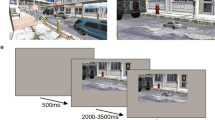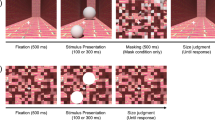Abstract
Natural scenes consist of objects of varying shapes and sizes. The impact of object size on visual perception has been well-demonstrated, from classic mental imagery experiments1, to recent studies of object representations reporting topographic organization of object size in the occipito-temporal cortex2. While the role of real-world physical size in perception is clear, the effect of inferred size on attentional selection is ill-defined. Here, we investigate whether inferred real-world object size influences attentional allocation. Across five experiments, attentional allocation was measured in objects of equal retinal size, but varied in inferred real-world size (for example, domino, bulldozer). Following each experiment, participants rated the real-world size of each object. We hypothesized that, if inferred real-world size influences attention, selection in retinal size-matched objects should be less efficient in larger objects. This effect should increase with greater attentional demand. Predictions were supported by faster identified targets in objects inferred to be small than large, with costlier attentional shifting in large than small objects when attentional demand was high. Critically, there was a direct correlation between the rated size of individual objects and response times (and shifting costs). Finally, systematic degradation of size inference proportionally reduced object size effect. It is concluded that, along with retinal size, inferred real-world object size parametrically modulates attention. These findings have important implications for models of attentional control and invite sensitivity to object size for future studies that use real-world images in psychological research.
This is a preview of subscription content, access via your institution
Access options
Access Nature and 54 other Nature Portfolio journals
Get Nature+, our best-value online-access subscription
$29.99 / 30 days
cancel any time
Subscribe to this journal
Receive 12 digital issues and online access to articles
$119.00 per year
only $9.92 per issue
Buy this article
- Purchase on Springer Link
- Instant access to full article PDF
Prices may be subject to local taxes which are calculated during checkout

Domino (a,d), Agarunov Oktay-Abraham; pool table (a,c), Juan Pablo Bravo; outlet (b), Blaise Sewell (all icons reproduced from https://thenounproject.com/)


Domino, Agarunov Oktay-Abraham (reproduced from https://thenounproject.com/)

Similar content being viewed by others
Data availability
The data that support the findings of this study are available from the corresponding author upon reasonable request.
References
Kosslyn, S. M. Information representation in visual images. Cogn. Psychol. 7, 341–370 (1975).
Konkle, T. & Oliva, A. A real-world size organization of object responses in occipitotemporal cortex. Neuron 74, 1114–1124 (2012).
Carrasco, M. Visual attention: the past 25 years. Vision Res. 51, 1484–1525 (2011).
Desimone, R. & Duncan, J. Neural mechanisms of selective visual attention. Annu. Rev. Neurosci. 18, 193–222 (1995).
Posner, M. I., Snyder, C. R. R. & Davidson, B. J. Attention and the detection of signals. J. Exp. Psychol. Gen. 109, 160–174 (1980).
Eriksen, C. W. & St. James, J. D. Visual attention within and around the field of focal attention: a zoom lens model. Percept. Psychophys. 40, 225–240 (1986).
Duncan, J. Selective attention and the organization of visual information. J. Exp. Psychol. Gen. 113, 501–517 (1984).
Valdes-Sosa, M., Bobes, M. A., Rodriguez, V. & Pinilla, T. Switching attention without shifting the spotlight object-based attentional modulation of brain potentials. J. Cogn. Neurosci. 10, 137–151 (1998).
O’Craven, K. M., Downing, P. E. & Kanwisher, N. fMRI evidence for objects as the units of attentional selection. Nature 401, 584–587 (1999).
Egly, R., Driver, J. & Rafal, R. D. Shifting visual attention between objects and locations: evidence from normal and parietal lesion subjects. J. Exp. Psychol. Gen. 123, 161–177 (1994).
Drummond, L. & Shomstein, S. The timecourse of space- and object-based attentional prioritization with varying degrees of certainty. Front. Integr. Neurosci. 7, 1–10 (2013).
Muller, N. G. & Kleinschmidt, A. Dynamic interaction of object- and space-based attention in retinotopic visual areas. J. Neurosci. 23, 9812–9816 (2003).
Shomstein, S. & Behrmann, M. Cortical systems mediating visual attention to both objects and spatial locations. Proc. Natl Acad. Sci. USA 103, 11387–11392 (2006).
Malcolm, G. L., Rattinger, M. & Shomstein, S. Intrusive effects of semantic information on visual selective attention. Attention, Perception, Psychophys. 78, 2066–2078 (2016).
Konkle, T. & Oliva, A. Canonical visual size for real-world objects. J. Exp. Psychol. Hum. Percept. Perform. 37, 23–37 (2011).
Jefferies, L. N., Gmeindl, L. & Yantis, S. Attending to illusory differences in object size. Attention, Perception, Psychophys. 76, 1393–1402 (2014).
Robertson, L. C. & Kim, M.-S. Effects of perceived space on spatial attention. Psychol. Sci. 10, 76–79 (1999).
Murray, S. O., Boyaci, H. & Kersten, D. The representation of perceived angular size in human primary visual cortex. Nat. Neurosci. 9, 429–434 (2006).
Konkle, T. & Oliva, A. Normative representation of objects: evidence for an ecological bias in perception and memory. In Proc. 29th Annual Cognitive Science Society (eds McNamara, D. S. & Trafton, J. G.) 407–412 (Cognitive Science Society, 2007).
Epstein, W. & Baratz, S. S. Relative size in isolation as a stimulus for relative perceived distance. J. Exp. Psychol. 67, 507–513 (1964).
Bar, M. Visual objects in context. Nat. Rev. Neurosci. 5, 617–629 (2004).
Long, B., Konkle, T., Cohen, M. A. & Alvarez, G. A. Mid-level perceptual features distinguish objects of different real-world sizes. J. Exp. Psychol. Gen. 145, 95–109 (2016).
Konkle, T. & Oliva, A. A familiar-size Stroop effect: real-world size is an automatic property of object representation. J. Exp. Psychol. Hum. Percept. Perform. 38, 561–569 (2012).
Malcolm, G. L. & Shomstein, S. Object-based attention in real-world scenes. J. Exp. Psychol. Gen. 144, 257–263 (2015).
Biederman, I. & Cooper, E. E. Size invariance in visual object priming. J. Exp. Psychol. Hum. Percept. Perform. 18, 121–133 (1992).
Kosslyn, S. M., Thompson, W. L., Kim, I. J. & Alpert, N. M. Topographical representations of mental images in primary visual cortex. Nature 378, 783–785 (1995).
Eckstein M. P., Koehler K., Welbourne L. E. & Akbas E. Humans, but not deep neural networks, often miss giant targets in scenes. Curr. Biol. 27, P2827–P2832 (2017).
Wolfe, J. M. Visual attention: size matters. Curr. Biol. 27, R1002–R1003 (2017).
Castiello, U. & Umiltá, C. Size of the attentional focus and efficiency of processing. Acta Psychol. (Amst.) 73, 195–209 (1990).
Martin, A. The representation of object concepts in the brain. Annu. Rev. Psychol. 58, 25–45 (2007).
Chao, L. L. & Martin, A. Representation of manipulable man-made objects in the dorsal stream. Neuroimage 12, 478–484 (2000).
Lakens, D. Calculating and reporting effect sizes to facilitate cumulative science: a practical primer for t-tests and ANOVAs. Front. Psychol. 4, 1–12 (2013).
Sekuler, R. & Blake, R. Perception 3rd edn (McGraw-Hill Education, New York, 1994).
Peterson, M. A. in Pioneer Visual Neuroscience: A Festschrift for Naomi Weisstein (ed. Brown, J.) 151–166 (Taylor Francis, New York, 2018).
Galera, C., Von Grünau, M. & Panagopoulos, A. Automatic focusing of attention on object size and shape. Psicologica 26, 147–160 (2005).
Herrmann, K., Montaser-Kouhsari, L., Carrasco, M. & Heeger, D. J. When size matters: attention affects performance by contrast or response gain. Nat. Neurosci. 13, 1554–1559 (2010).
Kravitz, D. J., Saleem, K. S., Baker, C. I., Ungerleider, L. G. & Mishkin, M. The ventral visual pathway: an expanded neural framework for the processing of object quality. Trends. Cogn. Sci. 17, 26–49 (2013).
Konkle, T. & Caramazza, A. Tripartite organization of the ventral stream by animacy and object size. J. Neurosci. 33, 10235–10242 (2013).
Peirce, J. W. PsychoPy-Psychophysics software in Python. J. Neurosci. Methods 162, 8–13 (2007).
Peirce, J. W. Generating stimuli for neuroscience using PsychoPy. Front. Neuroinform. 2, 1–8 (2009).
Rosenholtz, R., Li, Y. & Nakano, L. Measuring visual clutter. J. Vis. 7, 1–22 (2007).
Acknowledgements
This work was supported by a National Science Foundation grant no. BCS-1534823 to S.S. The funders had no role in study design, data collection and analysis, decision to publish or preparation of the manuscript. We thank G. Malcolm, D. Kravitz and M. Behrmann for insightful comments on an earlier version of this manuscript. Special thanks go to M. Peterson for suggesting a spatial frequency control experiment reported in experiment 3.
Author information
Authors and Affiliations
Contributions
A.J.C. and S.S. contributed to theoretical motivation, developed the study design and wrote the paper. A.J.C. programmed and conducted the experiments, performed data collection and analysis. J.C.N. and P.S.S. assisted with theoretical motivation, programming experiments and data collection, and provided revisions on manuscript drafts.
Corresponding author
Ethics declarations
Competing interests
The authors declare no competing interests.
Additional information
Publisher’s note: Springer Nature remains neutral with regard to jurisdictional claims in published maps and institutional affiliations.
Supplementary information
Supplementary Information
Supplementary Results, Supplementary Methods, Supplementary References, Supplementary Figures 1–6
Rights and permissions
About this article
Cite this article
Collegio, A.J., Nah, J.C., Scotti, P.S. et al. Attention scales according to inferred real-world object size. Nat Hum Behav 3, 40–47 (2019). https://doi.org/10.1038/s41562-018-0485-2
Received:
Accepted:
Published:
Issue Date:
DOI: https://doi.org/10.1038/s41562-018-0485-2
This article is cited by
-
Awareness-independent gradual spread of object-based attention
Current Psychology (2023)
-
Screen size matches of familiar images are biased by canonical size, rather than showing a memory size effect
Psychological Research (2021)
-
Attention scales with object size
Nature Human Behaviour (2019)



